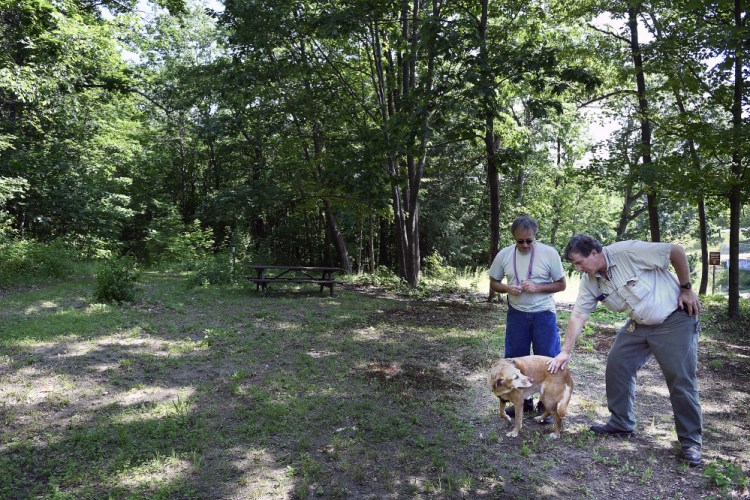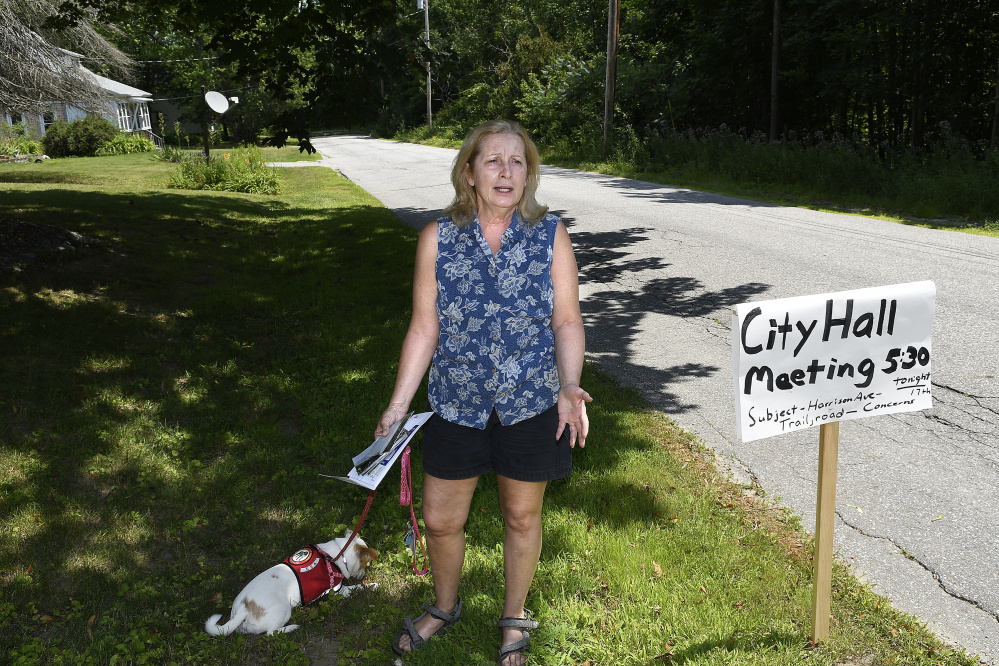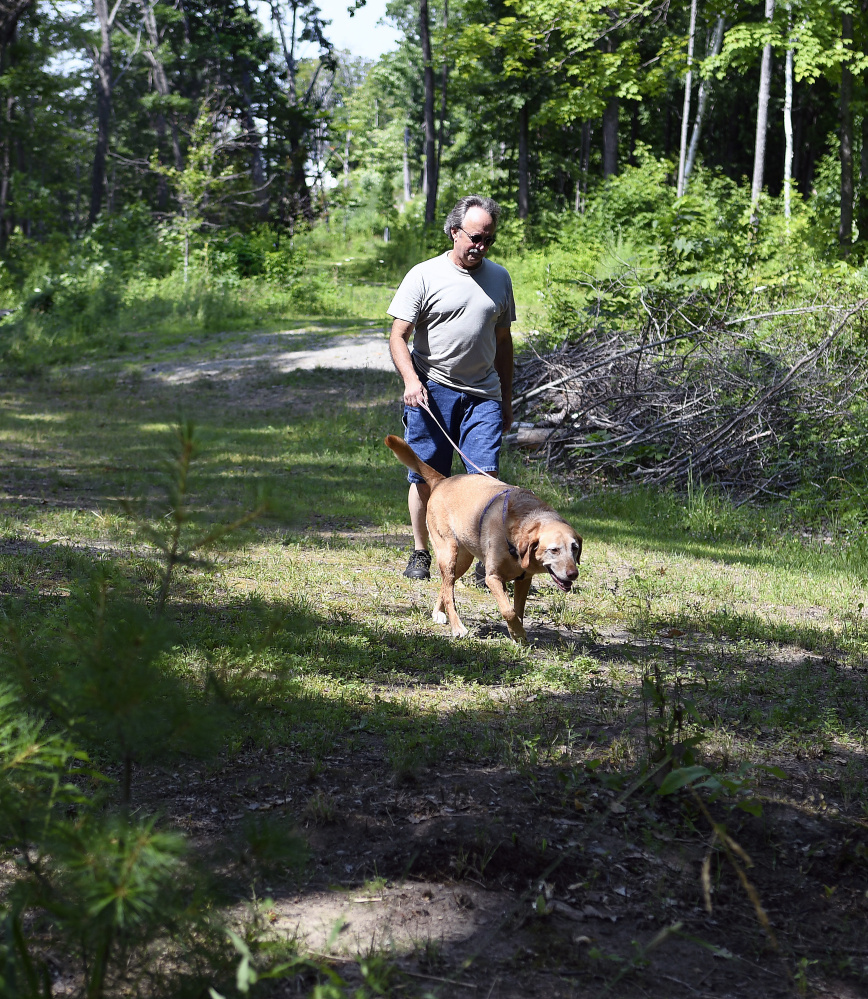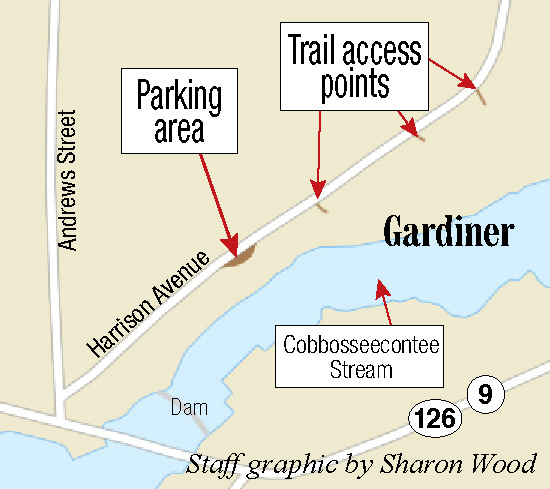GARDINER — As someone who lives on Harrison Avenue and walks on it every day, Barbara Jenner is worried about safety.
Harrison Avenue is a narrow residential street that runs between Cobbossee Avenue and Highland Avenue. Its route is defined by hills and curves with limited lines of sight.
It has no sidewalks.
And now that the Harrison Avenue Nature Trail has been formalized as part of the Cobbossee Corridor, more people are using the area, which has very limited parking to access the city property along the Cobbosseecontee Stream.
From Jenner’s perspective, that makes a dangerous situation worse.
On Monday, she said she’s been walking on Harrison Avenue when two semi-trailers passed each other and had to dodge them to avoid being hit.
She and seven of her neighbors brought their concerns to Gardiner city officials at a workshop Monday, as the result of a presentation she gave at a City Council meeting at the end of June. Even after spending an hour and a half talking about everything from trail maintenance, parking and safety, she’s not convinced city officials understand her concerns.
“I feel like the end of Harrison Avenue where we live is a forgotten part of the street,” she said.
Even before the Harrison Avenue Nature Trail was formally developed, Gardiner residents have been using Harrison Avenue as one leg of a walking route through the neighborhood north of Cobbossee Avenue, also known as Lewiston Road, just west of where it crosses Cobbosseecontee Stream.
People who live in the area often walk the loop from Harrison Avenue to Ash Street to Andrews Street, which intersects with Harrison Avenue. An alternate route is Harrison Avenue to Ash Street to West Hill Road to Cobbossee Avenue.
They are concerned that the traffic on Harrison Avenue is too fast, and the heavy use by school buses during the school year also pose a hazard.
But for all their concern, Gardiner Police Chief James Toman said, his department has received only one call for service this year on Harrison Avenue.
Toman, who lives nearby and walks through the area regularly, said he’s familiar with the traffic problems in the area.
“There has not been one call about speeding vehicles or parking,” he said. “(The Gardiner Police Department) can’t be everywhere at once, but I will tell you the squeaky wheel gets the grease.”
Toman said the department can increase patrols and use a portable sign board to remind people of the avenue’s 25 miles per hour speed limit.
While the traffic and visibility problems on Harrison Avenue have been happening for years, the trail has apparently shone a brighter light on the safety of walkers and runners in the neighborhood.
Karen Tucker had brought the idea of adding the pathway along the northern bank of the Cobbosseecontee Stream to Gardiner’s Cobbossee Corridor to the Gardiner City Council in October.
At the time she was president of the Gardiner Rotary Club, which had secured a matching grant from the regional Rotary organization. The Robinson Foundation had also committed $2,500.
The goal was to transform the informal path on the north side of the stream into a nature trail that would open up the area for the enjoyment of residents, and cut down on its use by youths who had used the area for swimming and nighttime bonfires.
Tucker, who has lived on Harrison Avenue since 2004, said clearing the brush on the trails has lessened the nighttime activity along the stream bank.
“I used to find clothing there regularly,” Tucker said Monday. “I haven’t seen any clothing down there recently.”
Tucker said she was the person who called the police over streamside activity that lasted late into the evening.
The funding that the Rotary Club raised went to posting signs at the entrances to the nature trail and to mark the parking area.
She said funding is available to add to the signs to make use of the area clearer, including warning people away from swimming in the stream, which is not allowed.
Even so, people have been swimming and using a rope swing tied to a tree over the water.
That practice came to an abrupt halt sometime over the weekend when the enormous oak tree toppled over into the stream.
“I don’t know who will take that out,” Public Works Director Tony LaPlante said; the removal will require some planning and work.
LaPlante said there are several things his department can do to ease some concerns. One is cutting back the brush along the side of Harrison Avenue that overlooks the stream and dumping gravel on along the guardrail to make a walking path to connect the parking area with the trailhead.
Adding sidewalks, however, is not something that his department can do.
“I don’t want anyone leaving here this evening thinking that’s a possibility,” interim City Manager Anne Davis said.
Harrison Avenue is not wide enough to accommodate sidewalks without property owners giving up part of their property, and the city has no money budgeted to pay for them.
District 2 City Councilor Patricia Hart, whose district includes Harrison Avenue suggested contacting the Boys and Girls Club to educate parents who use Harrison Road when they drop off or pick up their kids.
“It’s almost as bad as a camp road I used to have,” Jenner said in June. “On one side you get a hill and on the other side you have a rail.”
Jenner said the situation on Harrison Avenue doesn’t look hopeful.
“I just want a safe neighborhood,” she said,
Jessica Lowell — 621-5632
Twitter: @JLowellKJ
Send questions/comments to the editors.






Success. Please wait for the page to reload. If the page does not reload within 5 seconds, please refresh the page.
Enter your email and password to access comments.
Hi, to comment on stories you must . This profile is in addition to your subscription and website login.
Already have a commenting profile? .
Invalid username/password.
Please check your email to confirm and complete your registration.
Only subscribers are eligible to post comments. Please subscribe or login first for digital access. Here’s why.
Use the form below to reset your password. When you've submitted your account email, we will send an email with a reset code.